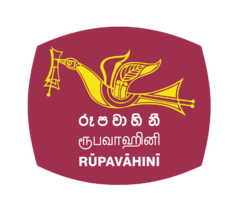Sri Lanka Rupavahini Corporation
 | |
| Type | Broadcast Television network |
|---|---|
| Branding | Rupavahini Corporation |
| Country | Sri Lanka |
| Availability | National |
| Slogan | The National Television of Sri Lanka |
| Headquarters | Sri Lanka Rupavahini Corporation, P.O.Box 2204, Independence Square, Baudhaloka Road, Colombo 07 |
Broadcast area | Sri Lanka |
| Owner | Government of Sri Lanka |
Key people |
Mr. Ravi Jayawardena (Chairman) Prof: M Sunil Shantha (Director General Rupavahini) [1] |
| Established | Sri Lanka Rupavahini Corporation (SLRC) Act no 6 of 1982 |
Launch date | 14 February 1982 |
Channel 1 | Rupavahini |
Channel 2 | Channel Eye |
Channel 3 | Nethra TV |
Channel 4 | NTV |
Official website |
www |
The Sri Lanka Rūpavāhinī Corporation (SLRC) ( ශ්රී ලංකා රූපවාහිනී සංස්ථාව; இலங்கை ரூபவாகினி கூட்டுத்தாபனம்) , also known as Jathika Rupavahini (lit. National Television) is the national television network of Sri Lanka. Gifted by the people of Japan to the people of Sri Lanka, mainly for the provision of education, information and entertainment.
Established by Parliament under Act No. 6 of 1982 for the provision of a national television service, it produces and broadcasts programmes in three languages. Distinguished civil servant M.J Perera was the Founder Chairman of Sri Lanka Rupavahini Corporation (SLRC).
SLRC is the largest television broadcaster in Sri Lanka and has an island-wide reception of its channels. SLRC broadcasts its channels in both VHF and UHF frequencies in Sri Lanka. Currently, all of the network's services are only available by analog transmission. But there are plans to upgrade to digital broadcasting. From 2011 Kokavil Transmitting starts DVB-T2 for North area in Sri Lanka. There were plans to Transmit the DVB-T2 Digital Transmission all over the country in 2015. The existing Analogous Transmission will be completely cut off.
History
Rūpavāhinī was created under a government act on January 23, 1982 and established on February 14th the same year.
Rupavahini began broadcasting on February 15, 1982, one day after it was established, with an opening speech from J. R. Jayewardene, Sri Lanka's president at the time, after being donated by the Japanese government. Both transmitters were built and installed by Japanese technicians.
In 1986, Rupavahini expanded their facilities and, in 1998, rehabilitated most of the original equipment using digital technology under three grant aid projects from the Government of Japan. Its studio complex is situated in Colombo, the commercial capital of Sri Lanka. The complex comprises a Master Control room, four studios, two dubbing studios, a Digital Post Production unit, two Analogue Post production units, several editing suites including Non Linear Editing and four Outside Broadcast vehicles.
Rupavahini 2 launched in April 1999 before it changed its name to the current name of Channel Eye in August 2000.
On January 1, 2008, Channel Eye became a timeshared channel, altering with the newly created Nethra TV.
Rupavahini is the first Sri Lankan channel to telecast foreign tele dramas. The most popular of them was Oshin, which was a Japanese teledrama dubbed with Sinhala.
In December 2014, the main channel was made available via satellite to Europe (via Eutelsat 70B), prompting the channel to temporarily go 24/7 (still doing the formal start and end of transmission routines) in order to alleviate timezone differences. Due to unknown reasons, the channel was removed. The channel now starts shortly before 04:00 and ends shortly after midnight.
Rupavahini's logo is a bird, more specifically a hill mynah carrying a message in gold on a red TV screen. It is generally accompanied by the channel's name in Sinhala, Tamil and a transliteration of Sinhala, with macrons (RŪPAVĀHINĪ). The leaf was incorporated into NTV's previous symbol and is also being incorporated into trophies held at award shows organized by the corporation, the Ape Gamana logo and the SLRC's news operation.
Currently the SLRC operates three channels over two frequencies.
Sister Channels
- Rupavahini is the main channel, in Sinhala. The channel transmits on a 20-hour schedule and features news, teledramas, educational programming, discussion shows and imported programming.
- Channel Eye is the English channel, operating in two blocks (05:45-07:30 and 21:00-23:30, times may change due to events). The channel's name is derived from the three focal points of the channel: Education, Youth and Entertainment. The channel airs a wide range of original productions and sporting events. In the first years of Channel Eye, it telecasted documentaries of Discovery Channel, and sport programs of both international and local, mainly the cricket, volleyball, and motor car racing. The channel also became the official TV broadcaster for five Cricket World Cup tournaments from 1996, 2003, 2007, 2011, and 2015.
- Nethra TV (Nethra is Tamil for "Eye") is the Tamil channel. It broadcasts on Channel Eye's frequencies between 07:30 and 21:00. The channel focuses on Tamil culture and customs with original and acquired programming, incluiding Tamil serials. It also airs an amount of religious programming, especially aimed at the religious minorities.
- Between 2009 and 2015, a fourth channel, NTV, was operated by the corporation. It aired contents entirely in English and was known to be a "worthless" channel upon the launch of it by critics. Eventually, the channel was shutdown later owing to low ratings.[2]
Management and Funding
It is an autonomous corporation run by Chairman, Director General and a board of directors appointed by the president. Until 1998 there was a subscription system to earn funds by having a subscription system, so that every television owner with VHF reception has to pay government a fee yearly. After a parliament act its programming and broadcasts fundings were made by television advertising and government grants.
See also
References
- ↑ "Management". 13 September 2015.
- ↑ "Playing TV - "Prime TV" and "N TV"". TV & Radio Sri Lanka.